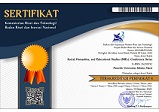Implementasi Model Discovery Learning berbantuan Media manipulative untuk meningkatkan Kemampuan Berpikir Spasial siswa dalam Pembelajaran Matematika di Sekolah Dasar
Abstract
Spatial thinking skills are an important component, especially in understanding geometric concepts and visual relationships between objects. One effective approach to developing these skills is the Discovery Learning model assisted by manipulative media. This study aims to examine the effectiveness of the model in elementary school mathematics learning. The method used is a literature study by reviewing various research results and relevant scientific publications in the last five years. The results of the study show that Discovery Learning combined with manipulative media is able to increase student involvement actively, strengthen understanding of spatial concepts, and encourage better visual representation. The conclusion of this study is that the combination of the discovery approach and concrete media has significant potential in supporting the development of students' spatial thinking skills from an early age.
Kemampuan berpikir spasial merupakan komponen penting, terutama dalam memahami konsep geometri dan hubungan visual antar objek. Salah satu pendekatan yang efektif untuk mengembangkan kemampuan ini adalah model Discovery Learning berbantuan media manipulatif. Kajian ini bertujuan untuk menelaah efektivitas model tersebut dalam pembelajaran matematika sekolah dasar. Metode yang digunakan adalah studi literatur dengan menelaah berbagai hasil penelitian dan publikasi ilmiah yang relevan dalam lima tahun terakhir. Hasil kajian menunjukkan bahwa Discovery Learning yang dipadukan dengan media manipulatif mampu meningkatkan keterlibatan siswa secara aktif, memperkuat pemahaman konsep spasial, serta mendorong representasi visual yang lebih baik. Simpulan dari kajian ini adalah bahwa kombinasi pendekatan penemuan dan media konkret memiliki potensi signifikan dalam mendukung pengembangan kemampuan berpikir spasial siswa sejak dini.
Keywords
Full Text:
PDFReferences
Alfieri, L., Brooks, P. J., Aldrich, N. J., & Tenenbaum, H. R. (2011). Does discovery-based instruction enhance learning? Journal of Educational Psychology, 103(1), 1–18. https://doi.org/10.1037/a0021017
Allen, A. (2022). An introduction to constructivism: its theoretical roots and impact on contemporary education. Journal of Learning Design and Leadership, 1(1), 1-11.
Andriyani, L., & Sudrajat, A. (2020). Pengaruh discovery learning terhadap kemampuan berpikir kritis matematis siswa sekolah dasar. Jurnal Cakrawala Pendas, 6(1), 23–29. https://doi.org/10.31949/jcp.v6i1.1933
Apriani, L., Wulandari, W., Hartatik, & Wijaya, R. B. A., (2024). TEACHERS' CHALLENGES IN IMPLEMENTING THE DISCOVERY LEARNING MODEL: A QUALITATIVE STUDY IN SECONDARY SCHOOLS. Jurnal Ilmiah Pendidikan Matematika, 6(2), 26–39. https://doi.org/10.36706/jls.v6i2.100
Bruner, J. S. (1961). The act of discovery. Harvard Educational Review, 31(1), 21–32.
Bouck, E. C., & Park, J. (2018). Concrete manipulatives in mathematics education. https://doi.org/:10.15294/jlj.v10i1.40076
Clements, D. H., & Sarama, J. (2009). Learning and teaching early math: The learning trajectories approach. Routledge. https://doi.org/10.4324/9780203883877
Creswell, J. W. (2014). Research design: Qualitative, quantitative, and mixed methods approaches (4th ed.). SAGE Publications.
Carbonneau, K. J., et al. (2013). A meta-analysis of the efficacy of teaching mathematics with concrete manipulatives. Journal of Educational Psychology. https://DOI.org/10.1037/a0031389
Disbudak, O., & Akyuz, D. (2019). The comparative effects of concrete manipulatives and dynamic software on the geometry achievement of fifth-grade students. International journal for technology in mathematics education, 26(1), 3-20. http://dx.doi.org/10.1564/tme_v26.1.01
Fitriani, D., & Nurjanah, S. (2021). Discovery learning dalam pembelajaran matematika SD. Jurnal Pendidikan Matematika Indonesia, 6(1), 45–52. https://doi.org/10.26737/jpmi.v6i1.2349
Ghazali, N. H. C., & Zakaria, E. (2011). Students’ procedural and conceptual understanding of mathematics. Australian journal of basic and applied sciences, 5(7), 684-691. http://www.ajbasweb.com/old/ajbas/2011/July-2011/684-691.pdf
Hosnan, M. (2014). Pendekatan saintifik dan kontekstual dalam pembelajaran abad 21. Ghalia Indonesia.
Imamuddin, M. (2020). Students’ understanding of mathematical concepts using manipulative learning media in elementary schools. In Journal of Physics: Conference Series (Vol. 1471, No. 1, p. 012050). IOP Publishing. http://dx.doi.org/10.1088/1742-6596/1471/1/012050
Moyer, P. S. (2001). Are we having fun yet? How teachers use manipulatives to teach mathematics. Educational Studies in mathematics, 47(2), 175-197. https://doi.org/10.1023/A:1014596316942
Nasution, R. S., Fauzi, K. M. A., & Syahputra, E. (2019). Developing mathematics problem based on PISA level of space and shape content to measure student’s mathematics problem solving ability. American Journal of Educational Research, 7(10), 660-669. https://doi.org/10.12691/education-7-10-1
NRC, N. (2006). Learning to Think Spatially. Washington, D.C: The National Academies Press.
OECD. (2019). PISA 2018 results (Volume I): What students know and can do. OECD Publishing. https://doi.org/10.1787/5f07c754-en
Page, M. J., McKenzie, J. E., & Higgins, J. P. T. (2018). Tools for assessing risk of reporting biases in studies and syntheses of studies: a systematic review. BMJ Open, 8(3). https://doi.org/10.1136/bmjopen-2017-019703
Paraniti, A. A. I., Dina, N. K., Diarta, I. M., & Hermawan, I. M. S. (2024). Membangun keterampilan berpikir kritis dan kemandirian belajar: Akselerasi mewujudkan profil pelajar Pancasila. Jurnal Pengabdian Masyarakat Indonesia, 4(2), 201-208. https://doi.org/10.52436/1.jpmi.1907
Putri, R. A., & Widiastuti, D. (2021). Model discovery learning dengan alat peraga manipulatif untuk meningkatkan kemampuan berpikir spasial siswa SD. Jurnal Pendidikan Dasar Nusantara, 6(2), 155–164.
Sarama, J., & Clements, D. H. (2016). Early childhood mathematics intervention. Science, 333(6045), 968–970. https://doi.org/10.1126/science.1204537
Schäfer, M. (2021). Manipulatives as mediums for visualisation processes in the teaching of mathematics. In Mathematics Teaching and Professional Learning in sub-Sahara Africa (pp. 5-21). Cham: Springer International Publishing. http://dx.doi.org/10.1007/978-3-030-82723-6_1
Sugiyono. (2018). Metode penelitian pendidikan: Pendekatan kuantitatif, kualitatif, dan R&D. Alfabeta.
Utami, R. W., Endaryono, B. T., & Djuhartono, T. (2018). Kemampuan peserta didik dalam menyelesaikan soal cerita matematika. Faktor: Jurnal Ilmiah Kependidikan, 5(3), 187-192.
Uttal, D. H., Meadow, N. G., Tipton, E., Hand, L. L., Alden, A. R., Warren, C., & Newcombe, N. S. (2013). The malleability of spatial skills: A meta-analysis of training studies. Psychological Bulletin, 139(2), 352–402. https://doi.org/10.1037/a0028446
Van de Walle, J. A., Karp, K. S., & Bay-Williams, J. M. (2010). Elementary and middle school mathematics: Teaching developmentally (7th ed.). Pearson Education.
Wardini, S. G., Kadir, K., & Dimyati, A. (2024). MODEL DISCOVERY LEARNING BERBANTUAN MEDIA GEOGEBRA DAN KEMAMPUAN LITERASI SPASIAL SISWA. ALGORITMA: Journal of Mathematics Education, 6(2).
Wu, J., Guan, J., Feng, K., Liu, Q., Wu, S., Wang, L., ... & Tan, T. (2025). Reinforcing spatial reasoning in vision-language models with interwoven thinking and visual drawing. arXiv preprint arXiv:2506.09965. http://dx.doi.org/10.48550/arXiv.2506.09965
Yang, D. C., Sianturi, I. A. J., Chen, C. H., Su, Y. W., & Trakulphadetkrai, N. V. (2022). Taiwanese primary school teachers perceived enablers for and barriers to the integration of children’s literature in mathematics teaching and learning. Educational Studies in Mathematics, 110(1), 125-148. https://doi.org/10.1007/s10649-021-10115-3
Refbacks
- There are currently no refbacks.




